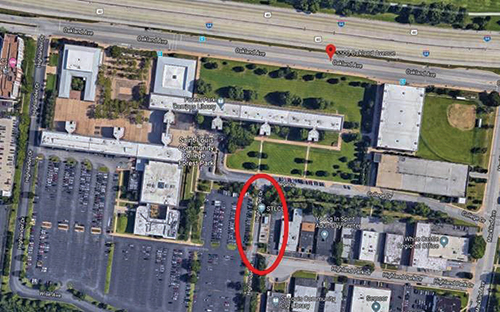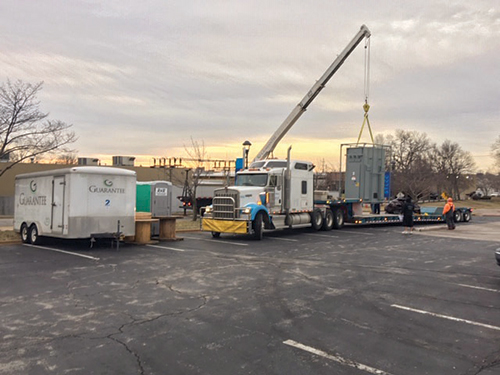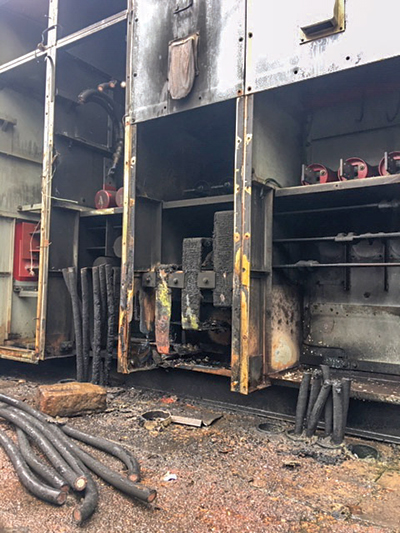
By Joshua Phelps
and Timothy Bold
The Scene staff
It wasn’t your typical power outage.
Forest Park’s electrical substation caught fire on Monday, Feb. 11, closing campus for a week.
“I heard from staff and students that there was a large boom that echoed across campus,” said Interim President Julie Fickas. “I’m grateful everyone’s safe and that Ameren UE, Guarantee, students and faculty showed flexibility dealing with the whole situation.”
The vast majority of classes, meetings and other activities were canceled. Food had to be salvaged in campus kitchens. Frozen pipes burst above a computer lab and classroom on the third floor of D Tower, leaking water onto computers and power sources.
“Some instructors were able to meet with students off-site,” Fickas wrote in the Forest Park Weekly online newsletter for employees.
“Budget hearings were conducted at Harrison Center … and items that needed to be moved due to the temperature issues created by the power outage were moved or cared for so that they would not go bad. The Meramec campus helped to store some items … including a turtle from biology.”
Campus reopened Tuesday, Feb. 19, but its electrical problems aren’t permanently fixed.
St. Louis Community College had to lease an external switch from a company in Houston to restore the power temporarily. It was installed by Guarantee Electrical, a private contractor that worked with Ameren.
“We will start the process of designing a new power substation for the campus, which will take a long time,” said Paul Zinck, vice chancellor of finance and administration for STLCC.
The college’s insurance company deemed the old substation a “total loss,” he said. The cost of damages and repairs still are being calculated.
Officials haven’t determined the cause of the fire.
“The wires and bars were melted already, leaving no consequential evidence,” said Joe Burns, project manager for Guarantee Electrical.
“I’m not sure if we’ll ever know exactly what the cause was,” said Dennis Dill, senior manager of facilities for STLCC. “But we suspect it may have either been a cat or a squirrel that got into the substation and touched a couple of components inside.”
Workers found evidence that an animal had been living in the substation, Dill said, adding, “There was nothing left of the animal.”

Loud noise, flickering lights
Forest Park’s substation is across the road from the staff parking lot on the east side of campus, in the vicinity of the Art Annex. It stopped working in the early evening Feb. 11.
Housekeeper Tiffany Beasley was emptying trash in the basement by the campus loading dock at the time.
“I heard a loud pop — BOOM!” she said. “I contacted my supervisor immediately on my walkie-talkie.”
Computer lab Supervisor Melih Guzel was in the computer lab on the third floor of D Tower when the power went out.
“All the lights and computers started flickering, and the whole room went dark,” he said. “I went around to see if anybody else was in the classrooms next door.”
The college’s emergency backup generators kicked in long enough for police to evacuate buildings.
“The evacuation went accordingly with no injuries,” said Lt. Adis Becirovic of Campus Police.
Officials assessed the situation and quickly determined that they had a big problem on their hands, said Andrew Langrehr, vice chancellor for academic affairs for STLCC.
The college sent emails to students, faculty and staff every day, starting Monday, notifying them that the campus would be closed the following day, he said. Some people also received text alerts.
“There was no power to the buildings, so you can’t hold classes or have people in class if your systems — including the safety systems — don’t have power,” Langrehr said.
Forest Park’s substation distributes 4,160 volts of electricity around campus, compared with about 120 volts for a typical house. It took Guarantee days to rewire transmission lines, run tests and wait for the leased switch to be shipped from Houston.
“It takes a lot of time to test all the components inside the substation,” Burns said. “We had to clean all the parts in order to safely test and turn it back on.”

Food salvaged, games moved
The extended power outage required swift action by Company Kitchen, the private company that operates the cafeteria.
Executive Chef Robert Klug brought in a truck with a frozen-food trailer and parked it next to the Hospitality Studies building.
“It had a generator that kept everything frozen,” he said. “I had to move everything out to the truck. We lost some produce. It can’t be frozen. It had to be thrown out.”
Students from the culinary arts department stopped in their kitchen daily to change dry ice for regulating food temperatures.
STLCC men’s and women’s basketball teams played their home games on the Meramec campus. The dental hygiene department had to reschedule teeth-cleaning appointments at its clinic.
“It was a nice little break from doing all this work,” said general transfer studies student Ciarra Hayl, 19.
But Hayl missed a meeting with her instructor for a late-start class and didn’t get out of other class requirements.
“The ones where I was not in class, they kept adding work online,” she said. “It was just a lot of work.”
College employees will not suffer financially because of the power outage.
“It’s handled similar to a weather closing,” Zinck said. “So if employees were scheduled to work on those days, they would be paid for those days as if they’re days worked.”
In her newsletter note, Fickas asked faculty and staff to check work areas, dispose of items that might be spoiled and report any equipment that’s no longer working properly.
Zinck predicts a new electrical substation will be installed during summer semester.
“It’s not a situation where the electric company will allow us to continue on a permanent basis,” Dill said. “That’s why the substation has to be replaced as soon as it can be feasibly done.”
